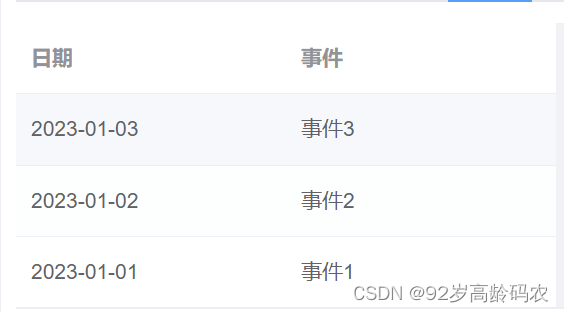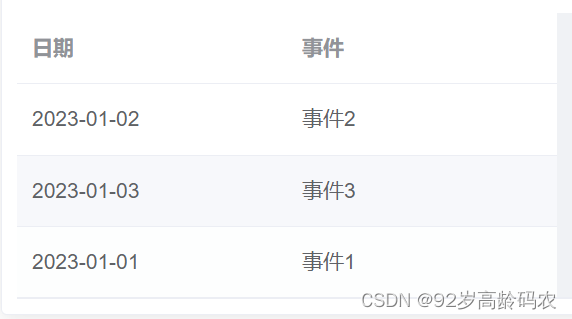Vue+ElementUI技巧分享:结合Sortablejs实现表格行拖拽
文章目录
- 前言
- 准备工作
- 示例代码
- 代码说明
- 1. 引入依赖和组件结构
- 2. 组件数据和生命周期
- 3. 实现拖拽功能
- 4. 更新数据和服务器同步
- 运行效果
- 总结
前言
在很多动态网页应用中,用户界面的交互性是提高用户体验的关键。在 Vue.js 中,结合 Element UI 和 sortablejs,我们可以轻松实现表格的行拖拽功能。本文将演示如何在 Vue 项目中使用这些工具,并在拖拽后将数据更新到后端服务系统。
准备工作
确保你的项目中已经安装了 Element UI 和 sortablejs。如果还没有安装,可以通过以下命令进行安装:
npm install element-ui sortablejs
在你的主入口文件(如 main.js 或 app.js)中引入 Element UI 和其样式:
import Vue from 'vue';
import ElementUI from 'element-ui';
import 'element-ui/lib/theme-chalk/index.css';
Vue.use(ElementUI);
示例代码
以下是一个包含表格行拖拽功能的 Vue 组件示例:
<template>
<div>
<el-table :data="planTableData"
row-key="id">
<el-table-column prop="createTime"
label="日期"
width="180"></el-table-column>
<el-table-column prop="event"
label="事件"
width="180"></el-table-column>
<!-- 其他列 -->
</el-table>
</div>
</template>
<script>
import Sortable from 'sortablejs'
import axios from 'axios' // 引入axios进行HTTP请求
export default {
name: 'PlanTableDraggable',
data () {
return {
planTableData: []
}
},
created () {
this.planTableData = [
{ id: 1, createTime: '2023-01-01', event: '事件1' },
{ id: 2, createTime: '2023-01-02', event: '事件2' },
{ id: 3, createTime: '2023-01-03', event: '事件3' }
// ...更多测试数据
]
},
mounted () {
this.$nextTick(() => {
const el = this.$el.querySelector('.el-table__body-wrapper tbody')
Sortable.create(el, {
onEnd: (event) => {
const { oldIndex, newIndex } = event
this.updateRowOrder(oldIndex, newIndex)
}
})
})
},
methods: {
updateRowOrder (oldIndex, newIndex) {
const movedItem = this.planTableData.splice(oldIndex, 1)[0]
this.planTableData.splice(newIndex, 0, movedItem)
this.updateOrderOnServer()
},
updateOrderOnServer () {
axios.post('/api/update-order', { newOrder: this.planTableData })
.then(response => {
console.log('Order updated:', response)
})
.catch(error => {
console.error('Error updating order:', error)
// 可能需要回滚操作
})
}
}
}
</script>
这段代码演示了如何在 Vue 组件中结合 Element UI 的表格和 sortablejs 来实现行拖拽功能。主要步骤包括初始化表格数据、配置 sortablejs 来启用拖拽,并在拖拽结束时更新数据和同步到服务器。通过这种方式,您可以创建一个交互式且用户友好的表格界面。
代码说明
1. 引入依赖和组件结构
<template>
<div>
<el-table :data="planTableData" row-key="id">
<!-- 表格列 -->
</el-table>
</div>
</template>
<script>
import Sortable from 'sortablejs'
import axios from 'axios'
export default {
// ...
}
</script>
<template>部分定义了组件的 HTML 结构。这里使用了 Element UI 的<el-table>组件来创建表格。:data="planTableData"是一个动态属性(Vue 的 v-bind 简写),它绑定planTableData数组到表格的数据源。row-key="id"用于指定每行数据的唯一键值,这里假设每个数据项都有一个唯一的id字段。import Sortable from 'sortablejs'引入sortablejs库,它用于实现拖拽功能。import axios from 'axios'引入axios库,用于发送 HTTP 请求。
2. 组件数据和生命周期
export default {
name: 'PlanTableDraggable',
data () {
return {
planTableData: []
}
},
created () {
this.planTableData = [/* 初始数据 */]
},
mounted () {
this.$nextTick(() => {
const el = this.$el.querySelector('.el-table__body-wrapper tbody')
Sortable.create(el, {/* 配置项 */})
})
},
// ...
}
data()函数返回组件的响应式数据,这里是planTableData数组,用于存储表格数据。created()生命周期钩子用于初始化planTableData。这里可以替换为从服务器加载数据。mounted()钩子在组件被挂载到 DOM 后执行。这里使用this.$nextTick确保所有的子组件也被渲染。- 在
mounted内部,我们通过this.$el.querySelector获取表格的 DOM 元素,并使用Sortable.create初始化拖拽功能。
3. 实现拖拽功能
Sortable.create(el, {
onEnd: (event) => {
const { oldIndex, newIndex } = event
this.updateRowOrder(oldIndex, newIndex)
}
})
Sortable.create接受两个参数:要应用拖拽的元素和配置对象。onEnd是一个事件处理器,当拖拽操作完成时触发。event参数提供了拖拽操作的详情,包括原始索引oldIndex和新索引newIndex。this.updateRowOrder是一个自定义方法,用于更新数组中元素的顺序。
4. 更新数据和服务器同步
methods: {
updateRowOrder (oldIndex, newIndex) {
const movedItem = this.planTableData.splice(oldIndex, 1)[0]
this.planTableData.splice(newIndex, 0, movedItem)
this.updateOrderOnServer()
},
updateOrderOnServer () {
axios.post('/api/update-order', { newOrder: this.planTableData })
.then(response => {
console.log('Order updated:', response)
})
.catch(error => {
console.error('Error updating order:', error)
})
}
}
updateRowOrder通过数组的splice方法调整planTableData中元素的位置。updateOrderOnServer使用axios发送一个 POST 请求到服务器,以同步更新后的顺序。这里的 ‘/api/update-order’ 是示例 API 端点,需要根据实际后端服务进行调整。
运行效果


总结
通过结合 Vue.js、Element UI 和 sortablejs,我们可以有效地实现一个交云用户友好的拖拽表格界面,并确保数据的一致性通过与后端服务的交互维护。这不仅提高了应用程序的交互性,还增强了用户体验。
